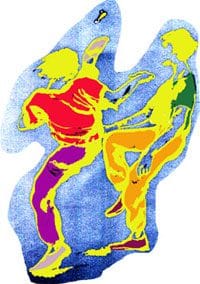
Whether it’s at the World Championship in Coaraze or on the small square of Saint Roch on a Sunday late afternoon, a game of Pilou, “Pilo” in Nice dialect, remains a moment filled with a multitude of symbols and traditions.
In every sport, it is necessary to have suitable equipment (soccer, basketball, pétanque), and sometimes even expensive equipment (skiing, tennis, golf). However, to play this sport, which seemingly originated in Nice during the 1940s, all you need to be “rich” with is a 25-centime coin from old French francs, pierced in its center (diam: 24mm – hole diam: 6mm – thickness: 1.5mm) and a piece of paper.
There’s no need to look elsewhere for traces of this Nice practice; neither Cannes, nor Antibes, and even less so Saint Tropez have succumbed to the appeal of this game, tinged with skill and finesse.
Pilo was played almost everywhere, from Old Nice to Saint Roch through the Port and the neighbouring Niçois hill villages. A Pilo, a piece of chalk, at least two players, and the tone is set for a game.
If we were to delve a bit further back in history, we speak of a game that arrived in Europe in 1520, “Tlachtli”, discovered in Central America and that bears many striking resemblances to the practice of Pilo, particularly because of the similarly punched coin used.
Then, the 1960s and the arrival of television in households saw the disappearance of the Sunday games on squares and little plazas. The game dwindled, the players faded, and Pilo entered a period of cruel anonymity. But the holed coin had not had its final say, and thanks to people like Jànluc Sauvaigo and Glaudo Nesci, Pilo tournaments were reborn in the region.
July 14, 1987, marked the return of Pilo to Nice, and it’s in Coaraze that you will find, each year in July, the now-traditional World Championship of the specialty.
But, curiously, Pilo is becoming, once again, rarer in neighborhoods and in that Old Nice, which was once one of the favored grounds of Pilo players.
These players of Pilo, for whom I have not found any other designation, despite numerous research efforts (Pilotiers, Pilouteurs, Piloutists).
I’m eagerly waiting for your suggestions and insights into this question.
I strongly recommend reading “E VIVA LO PILO” by André Giordan and José Maria, to learn all about the history and culture of Pilo.
Some quotes from our local personalities about Pilou:
André Barthe (Deputy for Culture – City Hall of Nice) – “I would like the contact details of the legislator who removed the holed coins.”
Philippe Jérome (Journalist) – “Pilo is my grandmother rummaging with her twisted fingers in her big black purse.”
Richard Cairashi (Comedian) – “Now the Pilo, you find them at numismatists. Pilo has become numismatic.”